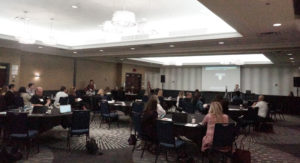At PSE marcomm conference, collaboration emphasized for success
By Nathan Lemay | June 2, 2022

During the past two plus years of COVID-19, we have all become familiar with the hopeful refrain that “We’re all in this together.” This is more true than ever for higher education communicators and marketers trying to spread awareness of their institutions in our emerging post-pandemic world.
Earlier this week, the 6th Annual Marketing & Communications for Post Secondary Conference was held in Toronto. Hosted by Summers Direct Conference & Events and Swansea Communications and chaired and partly sponsored by Sharon Aschaiek of Higher Ed Communications, this three-day hybrid professional development aimed to educate and inspire professional PSE marcomm practitioners with valuable insights, strategies, tactics, tools and techniques.

One key insight from the conference is that for institutions to address the challenge of getting the word out to prospective students, current students and alumni, communicators should work together with campus partners on marcomm projects to ensure meaningful approaches, cohesive messaging, smooth execution and sufficient exposure.
Campus partnerships at UBC
The power of campus partnerships to amplify awareness was made loud and clear by virtual presenter Anna Moorhouse, communications and marketing manager at the University of British Columbia Library.
In October 2021, UBC officially launched its Open Publishing Program, an open access journal and text service designed to help faculty, researchers, instructors, students and other staff advance publicly available scholarship. During her presentation, “A tale of three journals: How storytelling helped launch an open publishing program,” Moorehouse explained how she crafted a story-based marketing campaign over several months through interviews with UBC faculty, librarians and students across multiple disciplines.
Moorehouse’s narrative-based marketing campaign was cross-posted on multiple high-traffic campus channels across the institution with the help and involvement of campus partners, which helped achieve significant exposure for the initiative.
Cross-departmental collaboration at Sheridan
Multiple presentations throughout the conference emphasized the importance of email in connecting with higher ed students and alumni, especially “Reimagining the Student Newsletter by Sheridan College presenters. During their session, Patrick Naval, student communications specialist, and Carolina Salcedo, communications and public relations manager, explained how they created Sheridan’s first weekly newsletter, “Your Sheridan Weekly,” to raise awareness of key supports for students, and that they relied on cross-departmental collaboration to streamline useful content.
Understanding that during a pandemic—and even in a post-pandemic world—where students miss out on accessing school services and supports since they aren’t on campus, Naval and Salcedo saw the need for empathetic and proactive information. However, since students already indicated feeling overloaded with digital information and often miss “need-to-know” details buried in “nice-to-know” content, coordination between departments was crucial in tailoring an effective newsletter.
They sought the expertise of student-facing staff and created a set of student email guidelines, a content-submission process and best practices for creating content that is scannable with accessible language and tone. To avoid further overwhelming students with another email, Naval and Salcedo developed relationships with other departments that made them feel comfortable enough to “commit to reducing some of those communications and handing them over to us,” Salcedo said.
Interdepartmental team building at McMaster
Multiple presentations focused on the importance of multi-team cooperation to optimize and troubleshoot project processes, but “Beyond AODA compliance: Accessibility excellence and your website” by McMaster University marcomm staff went a step further by highlighting interdepartmental collaboration on a website build.
Using its award-winning Student Affairs web development process as a case study, marketing & communications strategist Jeffrey Low, digital media specialist Elizabeth DiEmanuele and web and graphic designer Ashley Fink explained how they collaborated across their respective units as well as with other departments and students to develop customized personas and ground their project testing in “lived experience.” This “empathy-first” approach helped them personalize users themselves, not just the barriers to accessibility, and achieve accessibility levels that go beyond what’s required by Ontario law.